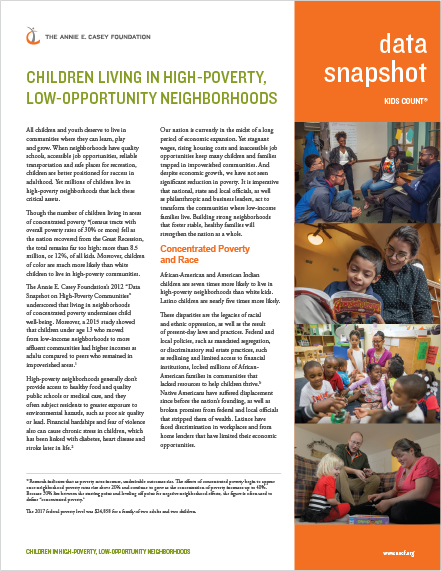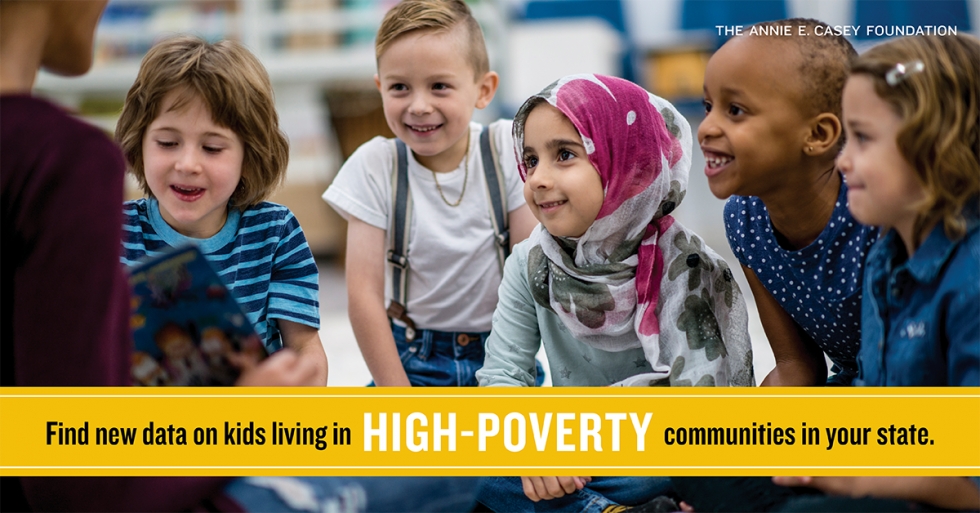Utah Shows Slight Improvement in the Number of Children Living inConcentrated Poverty
Native American children in Utah are twice as likely as children in the U.S. to live in concentrated poverty.
Salt Lake City, UT — The percentage of children in Utah living in concentrated poverty — that is, a neighborhood where 30 percent or more of the population is living in poverty — declined from a high of 6% in 2010-2014 to just 2% in 2013-2017 according to “Children Living in High Poverty, Low-Opportunity Neighborhoods,” a new KIDS COUNT® data snapshot released today by the Annie E. Casey Foundation. Using the latest data available from the U.S. Census Bureau, the snapshot examines where concentrated poverty has worsened across the country despite a long period of national economic expansion.
Utah’s rate of 2% in 2013-2017 (down from 3% in 2006-2010) compares to 12% nationally. Even so, there are 22,000 Utah children living in areas of concentrated poverty. Growing up in a community of concentrated poverty is one of the greatest risks to child development.
Children in high-poverty neighborhoods tend to lack access to healthy food and quality medical care and they often face greater exposure to environmental hazards, such as poor air quality, and toxins such as lead. Financial hardships and fear of violence can cause chronic stress linked to diabetes, heart disease and stroke. And when these children grow up, they are more likely to have lower incomes than children who have relocated away from communities of concentrated poverty.
Key findings from the snapshot include:
- American Indian/Alaskan Native children in Utah are much more likely to live in concentrated poverty at 24%
- Hispanic children in Utah are three times as likely to live in concentrated poverty (6%)
- Utah children living in metropolitan areas are more likely than their rural counterparts to live in concentrated poverty at 10% compared to 4% respectively.
- Immigrant children are slightly more like to live in these neighborhoods at 5%.
Voices for Utah Children joins the Casey Foundation in calling on national, state and local stakeholders to act now to help families lift themselves out of these circumstances. Policies at the community, county and state level that can have a significant impact on the lives of children in struggling families include:
- Supporting development and property-ownership models that preserve affordable housing, such as community land trusts and limited-equity cooperatives.
- Ending housing discrimination based on whether a person was formerly incarcerated or is using a federal housing voucher.
- Assisting low-income residents in paying higher property taxes that often come with new development/redevelopment or with a family’s relocation to a more affluent area.
- Expanding workforce training that is targeted to high-poverty, low-opportunity communities.
- Requiring and incentivizing anchor institutions to hire locally and contract with businesses owned by women and people of color.
- Developing and funding small-business loan programs that serve entrepreneurs in low-income neighborhoods and communities of color — or people that traditional lenders tend to reject, such as individuals with poor credit or criminal records.
Click here to read full report.
:






